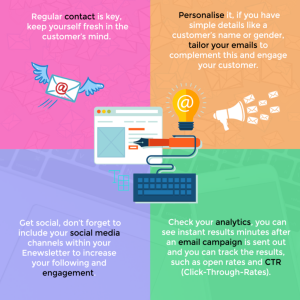
99% of the time, the written word is the chosen medium for companies doing inbound marketing. However, as I’m sure you know, not all writing is created equal. I’m certain you’ve encountered bad content online that isn’t doing anyone any favors. Content marketing is an investment, and you definitely deserve to see a return!
When you want to increase the profitability of your business, you can’t just email out a newsletter or post funny memes to your Facebook. You need to engage in strategic content marketing, with a goal of spreading the right messages to the right people. You need to draw potential customers to your website, and intrigue them with your brilliant words.
We are going to break down exactly how to craft content which will help you generate leads and customers. Making sales and acquiring new revenue is the purpose of marketing, right? After reading this blog, you’ll know how to create content that converts (or how to hire amazing writers to do it for you).
Give Them The Meaning: The Substance of Content

Writing is more than haphazardly throwing words up on your computer screen. Creating content isn’t about finding just the right mix of keywords and outbound links. In fact, sloppy SEO practices may attract a bit more traffic to your website, but not the kind of traffic that can lead to sales!
Remember, website traffic can be a vanity metric. Pure site visits don’t always equal sales. Even if your content is being read, you’ve also got to gauge your success by measuring your new leads and customers. The following list covers some key quality factors you should know and understand:
1. Be Relevant
You’re an expert at what you do, right? That’s not always a good thing when it comes to creating content your customers will value. The most important thing to understand when it comes to relevance is what matters to your customers.
Your content should always provide value to your target persona. What triggers your customers to come searching for your products? What are their priorities? Think of the problems that they face, and use your blog to present solutions to these issues.
2. Lose the Fluff

Adding a bunch of fluff to your blogs will only bore or annoy your readers. What do I mean by fluff? It can often manifest itself in the following forms:
- Terrible jokes or references to irrelevant insider information.
- Using your blog to publish “common sense” or low-value information.
- Content that isn’t plausible or credible because it lacks resources.
- Incredibly general information that’s not directly applicable to your audience.
If you’re struggling to find a few hundred words to say on a topic, the idea might not be worth publishing in the first place. Your audience is likely very busy, so indicate that you value their time by committing to only publishing high-value information.
Finally, be ruthless about editing your blogs to remove any hidden fluff from your content!
3. Remember to Sell
This is such a simple piece of advice, but so often bloggers forget they’re ultimately trying to generate leads and make sales. If your readers weren’t considering purchasing your products, they wouldn’t be researching your company in the first place.
Your blogs should never be an overt sales pitch. Your readers are most likely trying to perform research, not make an immediate purchase. However, it’s crucial that you take the time to write an enticing call-to-action at the end of your articles. These could include requests for ‘sharing the post,’ ‘subscribing to the blog,’ or ‘downloading your eBook.”
4. The Devil’s in the Details: Mind Presentation
The success of your writing is often only isn’t only about the main ideas and themes you choose to include. As much of 75% of your performance is related to how you treat small details. People notice mistakes, and small issues can detract from your company’s credibility.
You can lose subscribers, leads, and sales if you’re not careful enough. Here are some of the most commonly overlooked aspects of content marketing:
- Spelling, grammar, and word usage.
- Ensuring your links are working.
- Citations and remembering to include resources.
- Correctly-sourced images to engage readers.
5. Check Once, Check Twice, and Check Again
In an amusing and horrific story, Vox Media stated that the U.S. government lost $ 38.4 million, which wasn’t true. This statement was caused by a misplaced comma. Even more frightening, the BBC estimates that online businesses lose millions of dollars in sales due to spelling and grammar mistakes.
Grammar and spelling mistakes can be a major problem for business owners trying to create online content. Taking the time to remove 100% of your errors is difficult if you’re trying to edit your own work. Also, many business owners don’t have a bunch of time, money and energy to invest in sniffing out mistakes.
Editing can feel unnecessary and like a complete waste of time if you’re too busy. If your business is growing quickly and you’re struggling to fill orders, does it matter if your content includes a typo or two? Well, it actually does.
Don’t forget, but bad grammar and spelling can literally change the meaning of a piece of content. A blogger recently gave an example where they discussed a “cleaver marketing campaign” when she actually meant to use the word “clever”. No matter how small the mistake, it can result in a breakdown of communication with your reader.
What can you do to solve this issue if you’re tight on time and resources?
- Outsource your editing to a grammar and spelling-savvy professional
- Never edit your work immediately. Step away from the content so you can return with fresh eyes.
- Always have at least one person read over your content before publication, if possible.
6. Use Smaller Paragraphs
In any Journalism 101 class, students learn that short paragraphs are crucial for readable copy. Humans have limited attention spans. Even the most avid readers can get tripped up on long sentences and paragraphs. Write with the understanding that your content will be skimmed, not read-in-depth by most of your audience.
- Make paragraphs around two to four sentence long, so that you don’t lose the attention of potential customers.
- Avoid extraneous details that just aren’t relevant to what your readers really need to know.
- Avoid “walls of text” by using bullet-pointed or numbered lists to convey important information.
7. Be Consistent
Adding new, unique and compelling content can help draw traffic to a website. It also informs visitors that your business is alive and well, and can respond to their questions and concerns.
Do you feel confident about a company when their social media or blogs haven’t had a fresh post in months or even years? Absolutely not, and neither do most other people. Here are some ways to establish consistency among your marketing practices:
- Decide realistically how often you can post on your site and your social platforms.
- Develop a content creation calendar and follow it religiously.
- Stick to your schedule. Publishing occasionally is far better than stagnating or letting your blog go entirely quiet!
8. Be Resourceful
Adding high-quality resources to your work will enhance your credibility to readers and search engines. By citing your sources and research, it indicates expertise and that you’ve put some serious time into your content.
While adding resources may feel time consuming, it can only be to your advantage as a marketer. People today are often quite wary of organizations that over-promise and under-deliver. Using studies, statistics and news stories will add credibility to your claims about your product and its benefits.
TLDR?

Before you start marketing your business you may think that content marketing is easy. I mean, how hard can it be? You just throw some words on a page, and bam, see increased traffic to your site.
It may easy to write a blog or social media post, but it is not easy to do so in such a way that makes sales. If one is willing to put in the work to follow these quality content guidelines, you can make your website or blog a success:
- Be Relevant
- Lose the Fluff
- Remember to Sell
- The Devil’s in the Details: Be Careful About Presentation
- Check Once, Check Twice, and Check Again
- Use Smaller Paragraphs
- Be Consistent
- Be Resourceful
It’s a lot of extra work, but you’ll find the benefits are entirely worth it.
How do you increase the quality and success of your content marketing efforts? Share your tips in the comments!
Business Articles | Business 2 Community
(483)
Report Post






